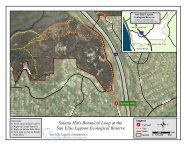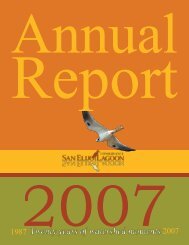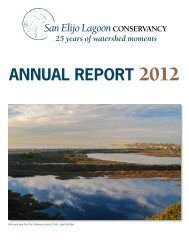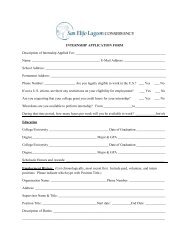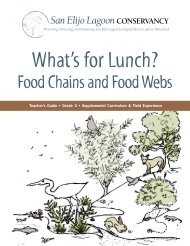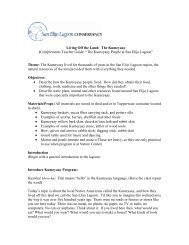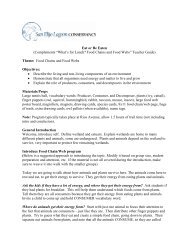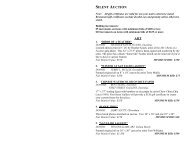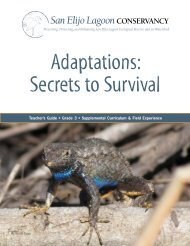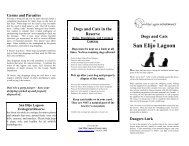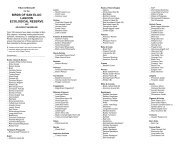Spring - San Elijo Lagoon Conservancy
Spring - San Elijo Lagoon Conservancy
Spring - San Elijo Lagoon Conservancy
You also want an ePaper? Increase the reach of your titles
YUMPU automatically turns print PDFs into web optimized ePapers that Google loves.
Searching for the Unseen By Wayne Green<br />
Understanding and Conserving <strong>San</strong> <strong>Elijo</strong> <strong>Lagoon</strong> through Genomics<br />
The <strong>San</strong> <strong>Elijo</strong> <strong>Lagoon</strong>, located in a world biodiversity hotspot, is a<br />
great resource for nature lovers and outdoor enthusiasts. Many people<br />
are drawn to the lagoon’s natural beauty and come to admire and<br />
photograph the wildlife that finds refuge in this urban environment.<br />
While the birds, fish and plants are beautiful, one of the lagoon’s<br />
most important, life-sustaining resources are the unseen microscopic<br />
organisms living there. To help conserve this oasis of biodiversity<br />
the <strong>San</strong> <strong>Elijo</strong> <strong>Lagoon</strong> <strong>Conservancy</strong> has teamed up with Synthetic<br />
Genomics, Inc., a privately held, La Jolla-based company developing<br />
genomic-driven solutions to address energy and environmental<br />
issues, to discover and better understand the microorganisms living<br />
in the lagoon.<br />
The lagoon supports biodiversity in an urban environment with<br />
diverse habitats ranging from estuary to coastal desert. Within these<br />
environments, unique biodiversity can be found at the microscopic<br />
level. Microorganisms play a key role in nutrient cycling; however,<br />
many of these microorganisms, and the roles they play, are unknown.<br />
This is because fewer than 99% of the microorganisms present<br />
in nature are able to be cultured or reproduced in a laboratory. By<br />
applying the tools of genomics to sequence DNA, scientists can better<br />
understand what organisms are living in the lagoon and how they<br />
impact that environment.<br />
“Synthetic Genomics is helping us to better understand the lagoon and<br />
its role as an island of nature surrounded by an urban environment,<br />
by elucidating the vast unseen world of microbes living there. This<br />
project is fundamental to sustaining and improving the long term<br />
health of the lagoon,” said Doug Gibson, Executive Director of the<br />
<strong>San</strong> <strong>Elijo</strong> <strong>Lagoon</strong> <strong>Conservancy</strong>.<br />
Scientists at Synthetic Genomics have been wading knee-deep in some<br />
of the lagoon’s most precarious waters to retrieve small samples which<br />
are then brought to the company’s research facilities on Torrey Mesa<br />
in La Jolla. There, DNA is extracted from microorganisms present<br />
in the samples. This DNA represents a pool of genomes, (all genetic<br />
information in an organism, and can be referred to as the metagenome<br />
or metagenomic DNA). Using DNA sequencers, this DNA can be read<br />
one base pair or letter at a time, A T G C G T C A G, etc, and is<br />
digitized into a computer. The metagenome is like a library of books<br />
and the DNA sequencer is the scanner. Once the samples are digitized,<br />
scientists can use computer search tools to discover and understand<br />
the microbes living in the lagoon.<br />
Synthetic Genomics is applying both natural and synthetic biological<br />
approaches to unlock the potential of plants and microbial resources<br />
for the development of commercial solutions for a cleaner and more<br />
sustainable future. The company is also working to minimize its impact<br />
on the environment through innovative waste reduction strategies and<br />
employee education programs, and working with organizations, like<br />
the <strong>San</strong> <strong>Elijo</strong> <strong>Lagoon</strong> <strong>Conservancy</strong>, to conserve biological diversity. v<br />
The diversity present in one scoop from the lagoon is stunning. Pictured above<br />
are a scanning electron micrograph (left) and a light micrograph (right)<br />
of the top layer of a bacterial mat. Many different types of photosynthetic<br />
microbes, organisms that harvest energy from the sun, can be seen. These<br />
same microorganisms could be utilized to convert greenhouse gases to<br />
advanced biofuels.<br />
Below, students help revegetate the berm of the old sewage settling ponds,<br />
the same area where the genomics samples were taken.<br />
4 | <strong>Lagoon</strong> Tidings



